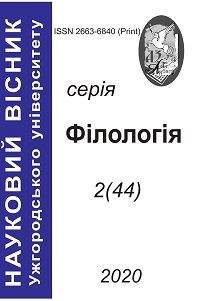COMPARATIVE IDIOMS OF THE CONCEPTUAL FIELD «HUMAN» IN LANGUAGE AND BEYOND
DOI:
https://doi.org/10.24144/2663-6840.2020.2.(44).226-230Ключові слова:
comparative idiom, concept, gender, male/female, component of meaning, lingual-culturalАнотація
The term “gender”, its relations to natural gender, and the question of arbitrariness of gender as a linguistic category and related issues have been discussed since Aristotle. Idiomatic units by definition are composed of a sequence of words whose meaning is different from their literal interpretation and their processing may involve further steps, such as realizing that the meaning of the phrases is not literal and associating the words with their figurative meanings. Across the languages of the world, gender systems vary widely which differ in the number of classes, in the underlying assignment rules, and how and where gender is marked. There must be 5 foci of an objective description of idioms: the figurative meaning, the contextual situation, the functions, the type, the structure. In the present paper the gender component and the interaction of its variants – masculine and feminine in the structure of the comparative idioms are of the major significance. The lingual-cultural approache and methods of cognitive linguistics to gender studies can clarify gender semantics of comparative idioms in order to give a model representa- tion of English gender-marked idioms, and explore gender lingval-cultural makers in the idiom corpus. A special place in the study of linguistic representation of gender is occupied by idiomatic units which can express established gender stereotypes in language, evaluative priorities of traits, characteristics of men and women, their social roles and relationships between them. There is an opinion that gender is a “socially and culturally conditioned phenomenon”and it is “one of the parameters of the human personality, which includes a biological entity, as well as a culturally determined mental construct, and “social gender in contrast to biological revealed in the process of social, cultural and linguistic practice. Comparative idioms as stereotypes contain people’s social experience -- their use facilitates and simplifies communication, saving the language efforts of interloc- utors. Baider stresses that stereotypes of thought highlight beliefs, attitudes and prejudices which prevail in a given community.

